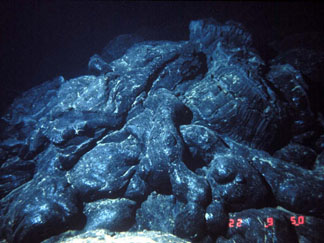Mid-ocean ridges are the place where the oceanic crust is expanding. It is where oceanic crust is diverging allowing magma to flow up from the mantle to form into new oceanic crust. They are large underwater mountain ranges.
A deep-ocean trench is a place where oceanic crust is subducting under continental crust due to the fact that oceanic crust is denser. Deep-ocean trenches are being pushed by the mid-ocean ridges.
The mantle might seem a little random, but it is there because you need to know about the convection currents and how they push and pull the continental plates.
All of those features fit together into the theory of seafloor spreading. When the convection currents in the mantle create mid-ocean ridges, the oceanic crust is pulled apart creating an opening in the crust to the mantle allowing magma to rise forming new oceanic crust. On either side of the mid-ocean ridge there is oceanic crust that is either subducting under continental crust at a deep-ocean trench, or pushing continental crust away from the mid-ocean ridge.
Click here to see animation for seafloor spreading
 |
| (http://panda3.phys.unm.edu/nmcpp/gold/phys161/lec/convection1.gif) |
There are several pieces of evidence behind the theory of seafloor spreading. They are: the igneous rock that makes up the oceanic crust; ages of the rock that makes up the oceanic crust; the magnetite pattern in the ridges.
One of the pieces of evidence is the igneous rock that forms along the mid-ocean rift. Scientists were puzzled why and how igneous rock formed under the ocean. The answer is the mid-ocean rifts allowing magma flowing from the mantle to rise up and form igneous rocks.
 |
| (http://serc.carleton.edu/images/research_education/cyberinfrastructure/ridge/pillowlava.v2.jpg) |
Another piece of evidence is ages of the oceanic crust. Scientists have found out what age of the sea floor is. They have fully mapped out all the oceans on Earth. If you look at the map below you will see the ranges of the ages of the oceanic crust. The younger crust would be found closer to the rifts because that is where the new crust is being created and the oldest crust would be father away from the rifts because the older crust is being pushed away by the newly formed crust.
 |
| (http://0.tqn.com/d/geology/1/0/V/J/seafloorage.gif) |
A third piece of evidence are the magnetic stripes that shows when the Earth's magnetic poles were reversed. The magnetic strips form when the magma rises. There is a magnetic mineral called magnetite in the magma that aligns itself with the magnetic poles when the magma is not solid yet. On the oceanic crust there are 2 different variations of the magnetite that point in different directions. Scientists think that the poles reversed periodically during Earths history. Since the strips form symmetrically across the rift, it shows how the oceanic crust is pushed evenly in both directions.
 |
| (http://en.wikipedia.org/wiki/Magnetic_striping#Magnetic_striping) |
Subduction at deep-ocean trenches determine whether the ocean grows or shrinks. If the oceanic crust subducts faster than the mid-ocean ridge expands, then the ocean would most likely shrink. If the trenches don't pull much under or are not there at all, then the ocean will most likely expand. When the oceanic crust subducts, the oceanic crust melts. Occasionally the melted material rises, because it is less dense, and forms a volcanic chain along the trench.
 |
| (http://www.vulkaner.no/v/vulkinfo/tomtech/image010.jpg) |
Currently, the mid-ocean ridges and deep-ocean trenches are hard at work changing the geography of the Earth. The Pacific Ocean is shrinking due to the amount of trenches surrounding it. Also the East Pacific Rise is much smaller than all the trenches combined. to compensate for the loss of ocean in the pacific, the Mid-Atlantic ridge is currently expanding the Atlantic because of the absence of trenches. The Indian Ocean is also growing larger too.
 |
| 2- Mid-Ocean Ridges 3- Deep-Ocean Trenches (http://www.geothermal-energy.org/pliki/Image/geo/What_is_geothermal_en_html_2f5bdb15.jpg) |
In class we made models of the mid-ocean ridges and deep-ocean trenches. The slits A and C represent the area where the paper/oceanic crust subducts. Slit B represents the mid-ocean ridge where the new crust is being formed. The paper that has slit A, B, and C (the black line below) in is the border between the lithosphere and the asthenosphere. The paper that goes through slits A, B, and C represents the oceanic crust. The different colored markings on the paper that goes through slots A, B, and C represent the magnetic stripes



No comments:
Post a Comment
Note: Only a member of this blog may post a comment.